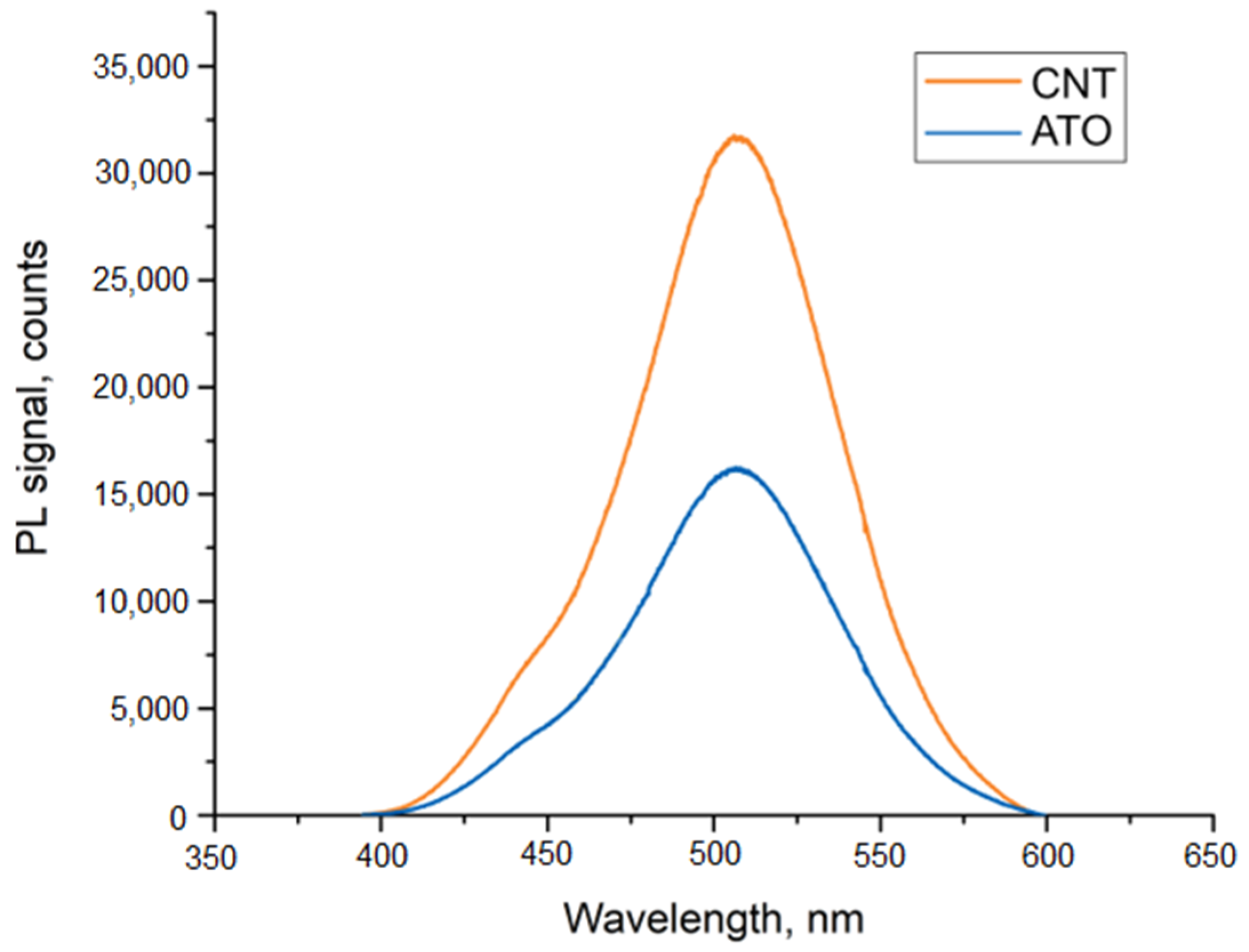Stretchable and Washable Electroluminescent Display Screen-Printed on Textile
Abstract
:1. Introduction
2. Materials and Methods
2.1. Materials
2.2. Preparations
2.3. Printing Process
3. Results
4. Discussion and Conclusions
Author Contributions
Funding
Conflicts of Interest
References
- Rogers, J.A.; Someya, T.; Huang, Y. Materials and mechanics for stretchable electronics. Science 2010, 327, 1603–1607. [Google Scholar] [CrossRef]
- Kim, S.J.; Choi, K.; Lee, B.; Kim, Y.; Hong, B.H. Materials for Flexible, Stretchable Electronics: Graphene and 2D Materials. Annu. Rev. Mater. Res. 2015, 45, 63–84. [Google Scholar] [CrossRef]
- Wu, H.; Huang, Y.A.; Xu, F.; Duan, Y.; Yin, Z. Energy Harvesters for Wearable and Stretchable Electronics: From Flexibility to Stretchability. Adv. Mater. 2016, 28, 9881–9919. [Google Scholar] [CrossRef] [PubMed]
- Khan, S.; Lorenzelli, L.; Dahiya, R.S. Technologies for printing sensors and electronics over large flexible substrates: A review. IEEE Sens. J. 2015, 15, 3164–3185. [Google Scholar] [CrossRef]
- Yakoh, A.; Álvarez-Diduk, R.; Chailapakul, O.; Merkoçi, A. Screen-Printed Electroluminescent Lamp Modified with Graphene Oxide as a Sensing Device. ACS Appl. Mater. Interfaces 2018, 10, 20775–20782. [Google Scholar] [CrossRef] [PubMed] [Green Version]
- De Vos, M.; Torah, R.; Tudor, J. A novel pneumatic dispenser fabrication technique for digitally printing electroluminescent lamps on fabric. In Proceedings of the Symposium on Design, Test, Integration and Packaging of MEMS/MOEMS, DTIP, Montpellier, France, 27–30 April 2015. [Google Scholar]
- De Vos, M.; Torah, R.; Beeby, S.; Tudor, J. Functional electronic screen-printing—Electroluminescent lamps on Fabric. Procedia Eng. 2014, 87, 1513–1516. [Google Scholar] [CrossRef]
- Sloma, M.; Janczak, D.; Wroblewski, G.; Mlozniak, A.; Jakubowska, M. Electroluminescent structures printed on paper and textile elastic substrates. Circuit World 2014, 40, 13–16. [Google Scholar] [CrossRef]
- Ferri, J.; Fuster, C.P.; Llopis, R.L.; Moreno, J.; Garcia-Breijo, E. Integration of a 2D touch sensor with an electroluminescent display by using a screen-printing technology on textile substrate. Sensors 2018, 18, 3313. [Google Scholar] [CrossRef] [PubMed]
- Bredol, M.; Dieckhoff, H.S. Materials for powder-based AC-electroluminescence. Materials 2010, 3, 1353–1374. [Google Scholar] [CrossRef]
- Getnet Tadesse, M.; Dumitrescu, D.; Loghin, C.; Chen, Y.; Wang, L.; Nierstrasz, V. 3D Printing of NinjaFlex Filament onto PEDOT:PSS-Coated Textile Fabrics for Electroluminescence Applications. J. Electron. Mater. 2018, 47, 2082–2092. [Google Scholar] [CrossRef]
- Verboven, I.; Stryckers, J.; Mecnika, V.; Vandevenne, G.; Jose, M.; Deferme, W. Printing Smart Designs of Light Emitting Devices with Maintained Textile Properties. Materials 2018, 11, 290. [Google Scholar] [CrossRef] [PubMed]
- Park, H.-J.; Kim, S.; Lee, J.H.; Kim, H.T.; Seung, W.; Son, Y.; Kim, T.Y.; Khan, U.; Park, N.-M.; Kim, S.-W. Self-Powered Motion-Driven Triboelectric Electroluminescence Textile System. ACS Appl. Mater. Interfaces 2019, 11, 5200–5207. [Google Scholar] [CrossRef] [PubMed]
- Kopyt, P.; Salski, B.; Olszewska-Placha, M.; Janczak, D.; Sloma, M.; Kurkus, T.; Jakubowska, M.; Gwarek, W. Graphene-Based Dipole Antenna for a UHF RFID Tag. IEEE Trans. Antennas Propag. 2016, 64, 2862–2868. [Google Scholar] [CrossRef]
- Janczak, D.; Peplowski, A.; Wroblewski, G.; Gorski, L.; Zwierkowska, E.; Jakubowska, M. Investigations of Printed Flexible pH Sensing Materials Based on Graphene Platelets and Submicron RuO 2 Powders. J. Sens. 2017, 2017, 2190429. [Google Scholar] [CrossRef]
- Lepak-Kuc, S.; Milowska, K.Z.; Boncel, S.; Szybowicz, M.; Dychalska, A.; Jozwik, I.; Koziol, K.K.; Jakubowska, M.; Lekawa-Raus, A. Highly conductive doped hybrid carbon nanotube-graphene wires. ACS Appl. Mater. Interfaces 2019. [Google Scholar] [CrossRef] [PubMed]
- Znajdek, K.; Sibiński, M.; Przymęcki, K.; Lisik, Z. Transparentne warstwy drukowane PEDOT jako kontakty emiterowe do aplikacji w elastycznych ogniwach fotowoltaicznych. Przegląd Elektrotechniczny 2014, 90, 101–104. [Google Scholar]
- Znajdek, K.; Sibiński, M.; Kubiak, A.; Ruta, Ł.; Lisik, Z.; Janczak, D. Analysis of back contact layers for flexible CdTe/CdS photovoltaic structures. Opto Electron. Rev. 2019, 27, 32–38. [Google Scholar] [CrossRef]








| No. | Layer Name: | Layer Thickness, µm | Summary Thickness, µm |
|---|---|---|---|
| 1 | protective layer | 12 ± 1 | 12 ± 1 |
| 2 | lower electrode | 10 ± 1 | 22 ± 2 |
| 3 | dielectric layer (2x) | 25 ± 2 | 47 ± 4 |
| 4 | electroluminescent layer | 8 ± 1 | 55 ± 5 |
| 5 | upper transparent electrode | 7 ± 1 | 62 ± 6 |
| 6 | transparent protective layer | 12 ± 1 | 74 ± 7 |
© 2019 by the authors. Licensee MDPI, Basel, Switzerland. This article is an open access article distributed under the terms and conditions of the Creative Commons Attribution (CC BY) license (http://creativecommons.org/licenses/by/4.0/).
Share and Cite
Janczak, D.; Zych, M.; Raczyński, T.; Dybowska-Sarapuk, Ł.; Pepłowski, A.; Krzemiński, J.; Sosna-Głębska, A.; Znajdek, K.; Sibiński, M.; Jakubowska, M. Stretchable and Washable Electroluminescent Display Screen-Printed on Textile. Nanomaterials 2019, 9, 1276. https://doi.org/10.3390/nano9091276
Janczak D, Zych M, Raczyński T, Dybowska-Sarapuk Ł, Pepłowski A, Krzemiński J, Sosna-Głębska A, Znajdek K, Sibiński M, Jakubowska M. Stretchable and Washable Electroluminescent Display Screen-Printed on Textile. Nanomaterials. 2019; 9(9):1276. https://doi.org/10.3390/nano9091276
Chicago/Turabian StyleJanczak, Daniel, Marcin Zych, Tomasz Raczyński, Łucja Dybowska-Sarapuk, Andrzej Pepłowski, Jakub Krzemiński, Aleksandra Sosna-Głębska, Katarzyna Znajdek, Maciej Sibiński, and Małgorzata Jakubowska. 2019. "Stretchable and Washable Electroluminescent Display Screen-Printed on Textile" Nanomaterials 9, no. 9: 1276. https://doi.org/10.3390/nano9091276
APA StyleJanczak, D., Zych, M., Raczyński, T., Dybowska-Sarapuk, Ł., Pepłowski, A., Krzemiński, J., Sosna-Głębska, A., Znajdek, K., Sibiński, M., & Jakubowska, M. (2019). Stretchable and Washable Electroluminescent Display Screen-Printed on Textile. Nanomaterials, 9(9), 1276. https://doi.org/10.3390/nano9091276






